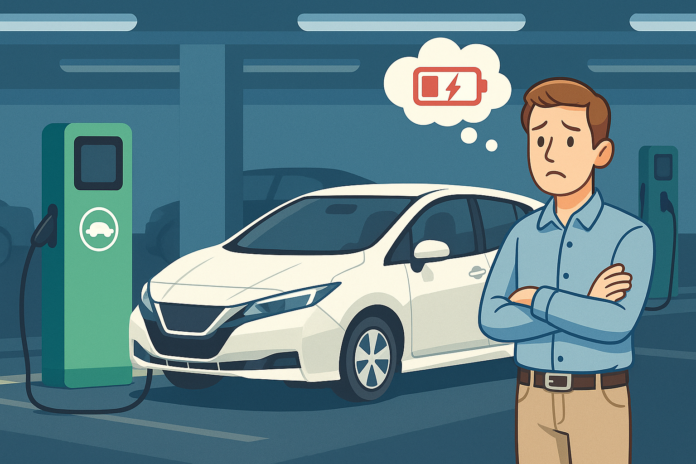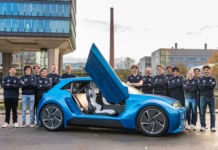The world’s transportation sector is undergoing a major transformation. Electric vehicles (EVs) are quickly becoming a central part of the shift toward sustainable travel. Since transportation is responsible for around 24% of global CO₂ emissions, switching from gas-powered cars to EV adoption is vital for meeting climate goals like those set in the Paris Agreement.
Still, despite growing environmental awareness and advancements in EV technology, adoption rates remain slower than expected in many places. Why? The reasons are varied—ranging from technical hurdles and infrastructure limitations to economic and social factors.
This article explores the main challenges holding back EV adoption and offers real-world solutions. Tackling these issues head-on is the key to accelerating the shift to clean mobility.
1. Charging Infrastructure: Still a Work in Progress
The Problem
Reliable charging stations are crucial for EV growth. Unlike gas stations, EV chargers aren’t yet everywhere. They’re especially scarce in rural areas and in apartment complexes where installing home chargers is tough. Also, there’s a big difference between fast chargers and slower ones, which adds to user frustration.
What’s Really Happening
- Charger Availability: The International Energy Agency (IEA) reported a 60% rise in public chargers in just two years. But in many countries, the ratio of EVs to chargers is still over 10:1—far from the ideal 3:1.
- City vs. Countryside: Cities have more chargers, while rural areas lag behind.
- Apartment Living: Roughly 30% of urban dwellers live in places without access to private charging.
Real-World Insights
- USA: California leads in charging access. In contrast, places like Mississippi have fewer than 50 chargers total.
- China: Over 2 million public chargers exist, but remote areas still struggle.
- Europe: The EU demands national plans for charger deployment, yet gaps remain between Eastern and Western countries.
Solutions
- Public Investment: U.S. infrastructure law allocates $7.5 billion for a national charging network. The EU is doing something similar through its Green Deal.
- Private Sector Help: Tesla’s Supercharger network is a great example. ChargePoint and Electrify America also work with local governments.
- Urban Planning: Amsterdam now requires EV-ready parking in new buildings.
- Flexible Options: Companies like SparkCharge offer mobile chargers for emergencies or events.
The Bottom Line
To support EV growth and adoption, charging needs to be fast, easy, and everywhere. A mix of government support, business innovation, and better urban planning can close the gaps.
2. Range Anxiety and Battery Limits
The Problem
People still worry about running out of power before reaching their destination. This fear—called “range anxiety”—stems from limited battery range, aging batteries, and poor performance in extreme weather.
Breaking It Down
- Battery Range: Early models like the Nissan Leaf had under 100 miles of range. Newer ones like the Tesla Model 3 now exceed 350 miles.
- Battery Aging: Lithium-ion batteries degrade 2–3% per year on average, affecting overall performance.
- Cold Weather: Batteries can lose up to 40% of their range in freezing conditions.
What We’ve Seen
- Tesla Model 3: Its long range and charging network make it a top choice for reducing range anxiety.
- Nissan Leaf: Newer versions now go 226 miles and include thermal management.
- Canada: Drivers often preheat their batteries in winter to avoid performance drops.
Solutions
- Better Batteries: Solid-state technology promises faster charging and better performance.
- Thermal Management: Systems that keep batteries at ideal temperatures are now common.
- Hybrid Options: Plug-in hybrids help bridge the gap by offering gasoline backup.
- Apps for Planning: Tools like PlugShare show real-time charger availability.
The Bottom Line
Thanks to better batteries and smarter tools, range anxiety is becoming less of a concern. Still, ongoing innovation is needed to keep building trust.
3. Charging Time: Still Slower Than a Gas Fill-Up
The Problem
Charging an EV still takes longer than fueling up at a gas station. Even with fast chargers, waiting 30–40 minutes isn’t ideal for everyone.
What You Need to Know
- Level 1: Adds 3–5 miles per hour. Good for overnight charging at home.
- Level 2: Adds 15–30 miles per hour. Found at workplaces and homes.
- DC Fast Charging: Delivers up to 200 miles in 30 minutes.
Charging too fast can damage batteries, so manufacturers have to balance speed and safety.
Real Examples
- Tesla: Superchargers add 250 kW and can charge to 80% in 30 minutes.
- Ionity (Europe): Offers ultra-fast 350 kW chargers for compatible cars.
- Workplaces: More employers now offer Level 2 charging for employees.
Solutions
- Ultra-Fast Charging: More 350 kW+ stations can cut down charging times significantly.
- Smart Charging: Charging at night reduces grid strain and costs less.
- Better Chemistry: New battery types charge faster without harming longevity.
- Destination Charging: Placing chargers where people park for long periods (like malls or offices) can help.
The Bottom Line
Faster charging, smarter grids, and more flexible options will make EVs more convenient for everyday use and help EV adoption.
4. Complicated Pricing Structures
The Problem
EV charging fees vary widely. Some are based on time, others on energy used, and some charge flat rates. This confuses drivers and may turn people away.
Key Details
- Per kWh: Easiest to understand and closest to how gas is priced.
- Per Minute: Can be unfair to slower-charging vehicles.
- Flat Fees: Simple, but not always fair.
Subscription models can make things more confusing.
What’s Happening
- ChargePoint: Offers both pay-as-you-go and memberships.
- Tesla: Charges per kWh, but prices vary by location.
- Retail Chargers: Some are free to attract customers, others charge high rates.
Solutions
- Transparent Pricing: Governments could require simple, per-kWh pricing.
- Flat Rate Plans: Memberships can offer predictable costs.
- Dynamic Pricing: Encourages off-peak charging to save money and ease grid loads.
- Oversight: Rules to prevent price gouging and ensure fairness.
The Bottom Line
Pricing should be easy to understand. When it is, more people will feel confident about switching to EVs.
More Roadblocks to EV Adoption—and How to Overcome Them
So far, we’ve looked at issues like limited charging infrastructure, range anxiety, long charging times, and confusing pricing. But that’s not the whole story. There are still more challenges to address before EVs can truly go mainstream.
Let’s dive into the next set of barriers—and the practical solutions that can help solve them.
5. Can the Electrical Grid Handle More EVs?
The Problem
A lot of people worry the power grid can’t handle millions of EVs charging at once—especially during peak hours. And in places where the grid is already under stress, this is a real concern.
What’s Really Going On
- EV Load Growth: By 2030, EVs could use about 10% of total electricity in some countries.
- Peak Demand: If most drivers plug in during evening hours, that could cause spikes and strain the system.
- Outdated Grids: Many older grids weren’t designed to handle this kind of load.
Real-World Observations
- California: On hot summer days, EV charging has been limited to prevent blackouts.
- Germany: The grid has handled EV growth better by encouraging daytime and off-peak charging.
- India: High demand in cities like Mumbai is raising red flags about future EV expansion.
Solutions
- Smart Charging: These systems delay or slow charging during peak hours to protect the grid.
- Time-of-Use Rates: Pricing electricity lower at night encourages drivers to plug in when demand is low.
- Vehicle-to-Grid (V2G): EVs can send power back to the grid when needed—like giant mobile batteries.
- Grid Upgrades: Governments and utilities are investing in stronger infrastructure.
The Bottom Line
EVs don’t have to break the grid. With smarter tech and better planning, they can actually help stabilize it.
6. Battery Degradation and Lifespan Worries
The Problem
EV batteries don’t last forever. Over time, they lose capacity, which reduces range and performance. That can scare off buyers, especially those used to gas vehicles that run well for 10–15 years.
What You Should Know
- Degradation Rates: Most batteries lose about 2% of capacity each year under normal use.
- Extreme Conditions: Heat and cold can speed up wear and tear.
- Charging Habits: Fast charging too often or charging to 100% all the time can shorten battery life.
Real-World Data
- Tesla Models: After 200,000 miles, many still have over 80% of original range.
- Nissan Leaf: Older models without cooling systems degraded faster—losing 20–30% within 5 years in hot climates.
- Fleet Vehicles: Taxis and ride-shares show that batteries can last up to 300,000 miles with smart charging habits.
Solutions
- Better Chemistry: Lithium iron phosphate (LFP) and solid-state batteries last longer and degrade more slowly.
- Battery Management Systems (BMS): These onboard systems protect the battery by adjusting charge speeds and levels.
- Battery Recycling: Companies like Redwood Materials and CATL are finding ways to reuse old battery materials.
- Extended Warranties: Most EVs now come with 8–10 year battery warranties for peace of mind.
The Bottom Line
Battery tech is improving fast, and smart habits can extend lifespan. For most drivers, EV batteries will easily outlast the car’s useful life.
7. Limited Vehicle Options—Especially in Some Markets
The Problem
Many buyers just don’t see an EV that fits their needs or budget. They might want a pickup truck, an SUV with lots of cargo room, or simply something affordable—but options can be slim, especially in developing countries.
The Current Landscape
- Luxury Overload: The early EV market was full of high-end models like the Tesla Model S and Porsche Taycan.
- Missing Segments: Until recently, there were few EV trucks, vans, or compact city cars.
- Slow Global Rollout: Some EVs are only available in certain regions due to regulations or production limits.
Real Examples
- Ford F-150 Lightning: A major step toward electrifying pickups in the U.S.
- Wuling Hongguang Mini EV: A best-seller in China under $5,000, perfect for cities.
- India and Africa: Mostly two- and three-wheel EVs so far, with few full-sized options.
Solutions
- Broader Lineups: Carmakers like Hyundai, VW, and BYD are rapidly expanding their EV offerings.
- Modular Platforms: “Skateboard” designs let manufacturers build multiple body styles on the same chassis.
- Government Support: Tax breaks or incentives can help automakers bring smaller, more affordable EVs to market.
- Import Reforms: Loosening restrictions can allow more global EV models to enter new markets.
The Bottom Line
More variety means more drivers can find an EV that fits their lifestyle. Expanding choices is essential to reach mass adoption.
8. High Upfront Costs and Economic Barriers
The Problem
Even with falling battery prices, many EVs still cost more than their gas counterparts. For buyers on a tight budget, this is a major roadblock.
Breaking It Down
- Battery Costs: Still make up about 30–40% of a car’s price.
- Purchase Price: EVs can be $5,000–$10,000 more expensive upfront than similar gas cars.
- Used EV Market: Smaller and more fragmented, making it hard to find deals.
Real Examples
- Tesla Model 3 vs. Toyota Corolla: The Tesla costs more up front but saves on fuel and maintenance over time.
- Norway: Offers big tax exemptions, making EVs cheaper than gas cars in many cases.
- U.S. and Canada: Federal and local rebates can knock off $7,500+ from the price.
Solutions
- Incentives: Government rebates, tax credits, and scrappage programs help reduce upfront costs.
- Leasing Programs: Let consumers try EVs without a long-term financial commitment.
- Lower-Cost Models: Automakers are starting to target the $25,000 price point—like GM’s upcoming Equinox EV.
- Used EV Support: Certified pre-owned programs and used-EV tax credits are gaining ground.
The Bottom Line
Prices are dropping fast, and incentives help close the gap. As the technology matures, EVs will become affordable for more people.
Final EV Adoption Barriers—and What’s Being Done About Them
We’ve covered charging challenges, battery concerns, limited vehicle choices, and high costs. But there are still a few final roadblocks holding back EV adoption.
Let’s finish this series by exploring the last set of obstacles—and the smart solutions already making a difference.
9. Resale Value and Long-Term Reliability Concerns
The Problem
Some buyers hesitate to go electric because they’re unsure how well EVs will hold their value. They’re also concerned about long-term maintenance and repair costs—especially with unfamiliar battery technology.
What’s Going On
- Depreciation Fears: Early EVs like the Nissan Leaf saw steep value drops due to outdated batteries and short range.
- Uncertainty: Many people are used to buying used gas cars. Used EVs feel like a gamble, especially when the battery warranty is nearing expiration.
- Repair Skills: Not all mechanics are trained to service EVs, which makes people nervous about long-term maintenance.
Real-World Data
- Tesla Models: Hold their value better than most gas cars, especially in markets with strong demand.
- Chevy Bolt: Had low resale for years, but recent price drops and incentives revived interest.
- Battery Warranties: Most EVs come with 8-year or 100,000-mile coverage—reassuring many buyers.
Solutions
- Certified Pre-Owned (CPO) Programs: Automakers now offer vetted used EVs with warranties and battery checks.
- Battery Health Reports: Tools like Recurrent give used-EV shoppers real-time battery data.
- Resale Incentives: Some countries offer tax breaks for used EVs, helping stimulate demand.
- Mechanic Training Programs: More workshops are specializing in EV repairs to increase buyer confidence.
The Bottom Line
With better warranty coverage and resale support, EVs are becoming a smarter long-term investment—both for new and used car buyers.
10. Lack of Consumer Awareness and Education
The Problem
Many people still don’t fully understand how EVs work, how to charge them, or whether they’re actually cheaper to run. Misconceptions and lack of experience can create hesitation—even when the facts are in favor of EVs.
What’s Behind It
- First-Time Fears: Drivers used to gas cars worry about charging, range, and reliability.
- Misinformation: Conflicting online content about EVs leads to confusion.
- Low Test Drive Rates: Without trying one firsthand, people remain skeptical.
Real-World Examples
- Surveys in the U.S. and UK: Many respondents still believe EVs can’t handle cold weather or long drives—despite plenty of evidence to the contrary.
- Rental Programs: Cities that offer EV test drives or short-term rentals often see higher EV adoption rates.
Solutions
- Public Awareness Campaigns: Governments and advocacy groups are promoting EVs through ads, social media, and events.
- Dealership Training: Educating sales staff to better explain EV features and benefits.
- Test Drive Events: Programs like “Drive Electric” let people try EVs for free in a low-pressure setting.
- Online Tools: Websites and apps help users estimate cost savings and compare EVs based on real-world data.
The Bottom Line
Experience builds confidence. When people get a chance to learn about EVs—or better yet, drive one—they’re much more likely to make the switch.
11. Environmental Concerns About EV Production
The Problem
EVs are marketed as “clean,” but some critics argue that the mining, manufacturing, and disposal of batteries create their own environmental issues. This raises valid questions about their true sustainability.
Key Points of Concern
- Battery Materials: Mining lithium, cobalt, and nickel has environmental and ethical risks.
- Manufacturing Emissions: Building an EV can generate more CO₂ upfront than a gas car.
- End-of-Life Waste: Batteries need to be recycled or reused—otherwise, they create toxic waste.
What the Research Says
- Full Lifecycle Analysis: Over their lifetime, EVs produce significantly fewer emissions than gas cars—even when charged from fossil fuels.
- Battery Recycling: Up to 95% of a battery’s valuable materials can be reused with current technology.
- Green Manufacturing: Tesla, BYD, and others are powering factories with solar and wind to reduce emissions.
Solutions
- Ethical Sourcing: Carmakers are investing in traceable, low-impact mining operations.
- Battery Recycling Infrastructure: Companies like Redwood Materials and Li-Cycle are scaling up.
- Second-Life Batteries: Old EV batteries can be repurposed for home energy storage or grid backup.
- Cleaner Supply Chains: Automakers are pushing suppliers to go carbon-neutral.
The Bottom Line
EVs aren’t perfect—but they’re still a massive improvement over fossil-fueled vehicles. With cleaner production and better recycling, their environmental impact will keep shrinking.
Final Thoughts: The Road Ahead for EV Adoption
Electric vehicles have come a long way in just a few years. While the road to widespread EV adoption still has bumps, most of the barriers we’ve discussed are already being addressed—with real solutions showing up in the market every day.
Here’s what it boils down to:
- Technology is improving rapidly.
- Charging networks are expanding.
- Costs are dropping.
- Awareness is growing.
The shift won’t happen overnight. But as these challenges are tackled one by one, the case for going electric becomes stronger—and clearer—for drivers around the world.







